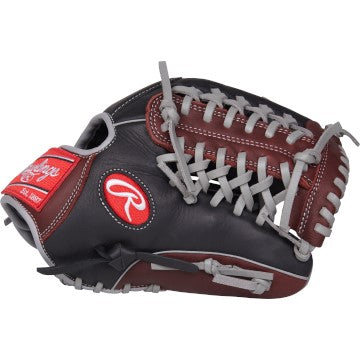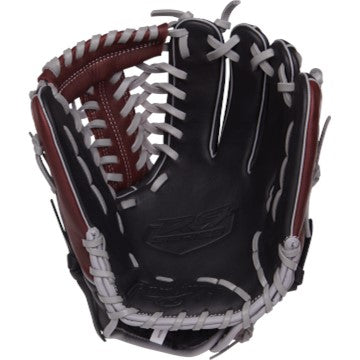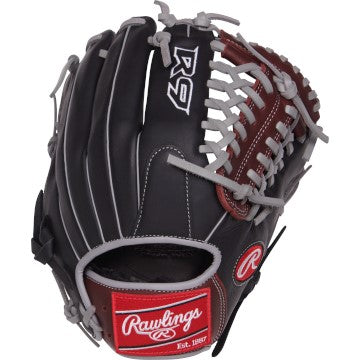Rawlings
Rawlings (R9205-4BSG) R9 Series 11.75" Baseball/Softball Glove
Couldn't load pickup availability
Price Match Promise
Price Match Promise
The Baseball and Softball Shop are proud to offer high quality baseball and softball equipment for the best prices possible. We regularly check our prices against competitors to ensure that we are offering the best value in the UK and Europe.
If you find the same product on the internet (company based in the UK or Europe), in stock at a lower price we will match the lower price. Please contact us with details.
Buyer's Guide
Buyer's Guide
Gloves, like the hands they fit, come in a variety of sizes. Baseball and softball gloves also are geared to fit both the position you play and the level of your game. Keep these factors in mind when you decide which style, size, features and materials best suit your game.
- Regular or Right hand?
- Fit the Glove to Your Hand / Sizing
- Gloves by Fielding Position
- Find the Features that Fit Your Game
- Care and Break-In of Your Leather Glove
1. Regular or Right hand?
A right hand glove is for a left handed thrower (right handed catch)
2. Fit the Glove to Your Hand / Sizing
Although age is also a factor, the position you play is the most important consideration in choosing a baseball or softball glove.
Youngsters/Beginners
Youth and Beginner:
Gloves that are too big allow "cheating," preventing beginners from developing and refining proper skills. Kids' gloves should not be bought to be grown into. The best way to learn the fundamentals of fielding and catching is by wearing a glove that fits well.
Kids 12 and Under:
No larger than 12 inches. Kids 7yrs and older should try 10 - 11 inch gloves, while younger kids (especially if they are smaller) should consider gloves in 9 - 10 inch range.
- Youth models are smaller to help kids maintain control
- Avoid the urge to buy a bigger glove that you'll grow into
- Kids under the age of 7 should stick with a glove from 9 to 10 inches
- Kids from 7 to early teens, consider a 10 - 11.5 inch glove
- Beginners also benefit from the added control that they get from smaller gloves
High School/ Adult
Adolescent: Choose the lower end of the adult size range for your position.
- Outfielders need 12 - 13 inch gloves with deeper pockets
- Infielders need smaller gloves (11 - 12 inch) with shallower pockets for better control and quicker ball transfer
- Pitchers can go with a slightly larger glove than infielders but still need a small enough glove for fielding and throwing quickly
- Softball players require gloves that are slightly longer in length and deeper in the pocket to help field the bigger ball
Softball (Adult)
- The larger sizes (13 to 14 inches) are manufactured for softball players.
- Outfielders typically wear gloves in the 12.5 - 14 inch in range because the large pocket makes for great catching.
- Infielders looking for quick transfer often use a slightly smaller glove, between 12 - 13 inches.
- Pitchers, like infielders, usually prefer the quick transfer of smaller, 12 - 13 inch gloves
- Middle infielders should look for a shallower pocket within the recommended size range.
- Recreational Baseball/Softball Adults
- As a rule of thumb an adult lady would use a 12 inch glove (such as the Rawlings 12 inch Playmaker or Renegade series) and an adult male a 13 inch glove (such as the Rawlings Playmaker or Renegade series). A male with small hands may want to go for a 12 - 12.5 inch option.
|
Sizing Chart |
||
|
Age |
Position |
Glove size |
|
Under 7yrs |
Infield |
9 - 10 inches |
|
Under 7yrs |
Outfield |
9 - 10 inches |
|
7-10yrs |
Infield |
10 - 11 inches |
|
7-10yrs |
Outfield |
10 - 11.5 inches |
|
11-14yrs |
Infield |
11 - 11.5 inches |
|
11-14yrs |
Outfield |
11- 12 inches |
3. Gloves by Fielding Position
Gloves are made to better help you field your position. A key element in determining the size mitt you buy is the position you play in the field.
Catcher
- A fingerless mitt (it does not have individual fingers)
- Has heavy padding to reduce the sting from the pitcher's throw
- Reinforced to withstand the heavy use throughout a game
First base
- Also resembles a mitten, but has less padding than the catcher's mitt
- It is longer to help the first baseman field throws from infielders
- A shallow pocket allows the first baseman to quickly retrieve the ball from the mitt
Infield
- A five-fingered glove with a shallow pocket
- A youth size is between 9 - 11.5 inches
- Adults 11-12 inch is the typical baseball size
- Softball infielder gloves have a deeper pocket to accept the bigger ball
- Second basemen need a smaller glove to help make those quick throws while still having control
- Shortstops use something in the middle for grounders and quick throws
- Third basemen need a larger glove
Outfield
- Usually sized at 12 -13 inches for adults, about 11 inches for children
- A deeper pocket to handle balls hit high in the air
- Longer length to give as much reach as possible
- If you plan to play several positions, find a glove that provides the most control for a variety of outfield positions
Softball
- Generally larger both in the pocket and length to help players handle the larger ball up to 15 in
- If you play both baseball and softball, and you only want to buy one glove, select a softball glove
4. Find the Features that Fit Your Game
Today's gloves have different features built-in to help your game and to suit your ability. Here are the key features constructed into gloves and what to consider in finding the glove that suits you.
Construction
Webbing
- Different styles of webbing are available to either help you better field your position or to fit your preference
- A closed web is preferred for pitchers who want to hide the ball from the batter
- Outfielders and third basemen like the extra support from a closed web
- An open web helps middle infielders get the ball out of their gloves quicker to make throws
Backs
- There are two choices of backs, open or closed
- The type of back is matter of personal preference, but some styles fit some positions better
- The open back leaves a space open across the glove's back
- Middle infielders prefer this for the flexibility
- Outfielders prefer a closed back with a "finger hole" for extra support
Wrist adjustment
- Gloves come with an adjustment to keep it snug. Not all gloves have these "fit systems."
- A D-ring fastener allows you to pull on the lacing and make the glove tighter or looser
- A Velcro fastener although it may wear quicker, offers convenience of pulling and adjusting to fit your comfort level
- A Lacing adjustment allows you to loosen or tighten the wrist fastener with leather laces.
- A Buckle system adjusts the glove with a buckle similar to an adjustable hat
Padding
- The amount of padding in the pocket depends on the position played
- The catcher's mitt has more padding to handle hard throws from a pitcher
- Glove makers have been adding more padding for other positions as well to help players handle the sting of hard-hit balls
- There also may be padding in the wrist area to make the glove more comfortable
Materials
Gloves come in a variety of materials, with the difference being in the feel and durability.
Leather
- Materials of choice for gloves
- Leather offers the best comfort, control and feel
- The better the leather, the better the glove
Synthetic materials
- A lighter, less-durable material
- Less expensive, good for youngsters
- Won't withstand the wear and tear of playing ball nearly as well as leather
5. Care and Break-In of Your Leather Glove
- Pour a small amount of glove conditioner or glove oil on a clean dry cloth and carefully work the oil around the outer shell palm and back. A light coating is all that is necessary.
- Allow the glove to dry thoroughly for 24 hrs.
- Wipe off any excess oil and play catch for 10-15 minutes or 50-70 throws. This stretches and forms the glove to your hand and accelerates the break-in process.
- Put a ball in the pocket of the glove and tie the glove closed for a few days with a string or rubber band.
- Laces will stretch with use. Keep the laces taut but do not over-tighten them.
- Store in a cool dry place with a ball in the pocket when not in use. Do not leave your glove in an area where temperatures will become extreme, such as the boot of your car.
- Do not over-oil your glove. Twice per season is sufficient.
- Do not submerge your glove in water -- it will rot. If your glove becomes wet, dry slowly and oil lightly. Do not put in the oven or microwave to dry it.
Series Features
• Soft, durable all-leather shell designed to be game-ready
• Pro style patterns
• Reinforced palm pad for impact reduction
• Padded thumb loop for added comfort
• Padded fingerback liners for a soft, comfortable feel
• Standard and Narrow Fit
Product Features
• Conventional Back
Glove Forming/Break-in: 80% Factory/20% Player






